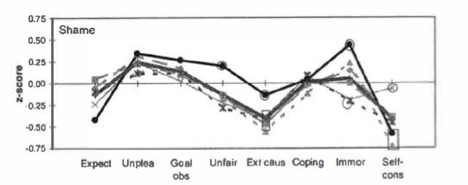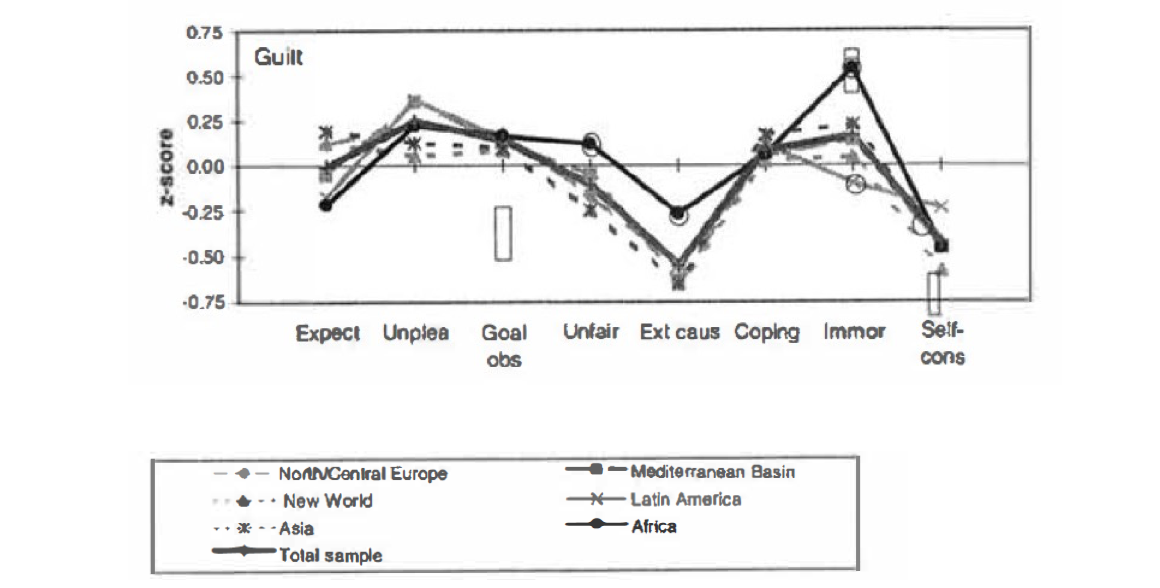Chapter 11: Negative Self-Conscious Emotions
Distinct Emotion Theory – Cognitive Appraisals
According to Tangey et al. (1992), shame is caused by a “bad self” attribution, whereas guilt is caused by a “bad act” attribution. When we make a bad self cognitive appraisal, we acknowledge that we made a specific transgression AND we make a negative evaluation of the global self. This means because of our transgression we view the entire self as a bad individual. For instance, I might say “I lied to my romantic partner – I’m a bad person.” Guilt is caused when we acknowledge the specific transgression, but we do NOT perceive the self as global, horrible individual. For example, we might think, “I lied to my romantic partner, but that doesn’t make me a bad person. I lied to make them feel good.” Embarrassment occurs when we realize that other people are focused on the self and evaluating us (Tangney et al., 1996). For instance, “I tripped down the stairs in my dorm and other students are staring at me.” The focus on the self could also be due to a positive behavior that we exhibit, “I am giving the valedictorian speech and everyone is listening to me.”
Other cognitive appraisals might help differentiate the self-conscious emotions. During shame (vs. guilt), participants reported more focus on other people’s thoughts (demonstrating theory of mind). Guilt and shame result in equal levels of acknowledging responsibility for the behavior and immorality (Tangney et al., 1996). Embarrassment, compared to shame and guilt, was associated with higher levels of unexpectedness, event occurring suddenly, and less responsibility for behavior. When predicting others’ thoughts, people recalling embarrassment believed other people felt more amusement and less negative emotions toward the violation (Tangney et al., 1996).
Scherer (1997) investigated the cognitive appraisals associated with shame and guilt. In his study, he asked participants to recall a time they experienced shame or guilt (for more information on this study, go to this section). Means (see Table 6), collapsed across all world regions, show that participants reported the following appraisals when recalling an shame/guilt experience: unexpected, unpleasant, no changes in goal obstruction, fair, self/internal causation, pretend nothing happened coping strategy, a little immoral, and reduced self-esteem. It is important to note that participants reported both shame and guilt were caused by internal attributions and people perceived a temporary drop in self-esteem. The drop in self-esteem is probably a contributor to the unpleasant feelings associated with shame and guilt. Also, participants reported that they would cope by pretending nothing happened, which aligns with the avoidance behavior associated with shame. Compare the means for shame and guilt for each cognitive appraisal dimension. Are they similar or different? What does this study tell us about whether shame and guilt are similar or different emotions?
Table 6
Mean Changes in Cognitive Appraisal Dimensions for Anger (Scherer, 1997)
| Cognitive Appraisal Dimension | Mean Shame | Mean Guilt | Question | Response Scale |
|---|---|---|---|---|
| Expectedness | 1.48 | 1.58 | Did you expect this situation to occur? | 1 = not at all; 2 = a little; 3 = very much |
| Unpleasantness | 2.80 | 2.78 | Did you find the event itself pleasant or unpleasant? | 1 = pleasant; 2 = neutral; 3 = unpleasant |
| Goal Obstruction | 2.33 | 2.32 | Did the event help or hinder you to follow your plans or achieve your aims? | 1 = it helped; 2 = it didn’t matter; 3 = it hindered |
| Unfairness | 1.73 | 1.77 | Was the situation unjust or unfair? | 1 = not at all; 2 = a little; 3 = very much |
| External Causation | 1.63 | 1.47 | Who you think was responsible for the event? | 1 = self/internal; 2 = close persons/external; 3 = other persons/external; 4 = impersonal agency/external |
| Coping Ability | 3.13 | 3.25 | How did you evaluate your ability to act on or to cope with the event and its consequences? | 1= powerless; 2 = escape possible; 3 = pretend nothing happened; 4 = no action necessary; 5 = could positively influence event and change consequences |
| Immorality | 1.95 | 2.05 | Would this behavior itself be judged as improper or immoral by your acquaintances? | 1 = not at all; 2 = a little; 3 = very much |
| Self-esteem | 1.45 | 1.43 | How did this event affect your self-esteem? | 1=negatively; 2= not at all; 3 = positively |
Adapted from “The Role of Culture in Emotion-Antecedent Appraisal,” by K.R. Scherer, 1997, Journal of Personality and Social Psychology, 73(5), p. 905, 911 (https://doi.org/10.1037/0022-3514.73.5.902). Copyright 1997 by the American Psychological Association.
Figure 13
Eight Cognitive Appraisal Ratings for Shame (Top) and Guilt (Bottom) across Six World Regions (Scherer, 1997)
Long Description
The image consists of a line graph depicting data on “Shame” based on z-scores for various cultural groups. The graph features the x-axis categories of Expect, Unplea, Goal obs, Unfair, Ext caus, Coping, Immor, and Self-cons.
The graph shows a collection of lines representing different cultural regions: North/WCentral Europe, New World, Asia, Mediterranean Basin, Latin America, Africa, and the Total sample. Each line varies in style, including solid, dashed, and dotted, with distinct markers like circles, squares, and triangles. The z-score ranges from -0.75 to 0.50 on the y-axis.
Long Description
The image displays a line graph that illustrates the z-scores for “Guilt” based on various factors across different world regions. The x-axis lists factors: Expect, Unplea, Goal obs, Unfair, Ext caus, Coping, Immor, and Self-cons. The y-axis represents the z-score ranging from -0.75 to 0.75. Multiple lines represent different regions: Non/N/Central Europe, New World, Asia, Total sample, Mediterranean Basin, Latin America, and Africa. Each line is differentiated by unique markers such as dashes, dots, and shapes. The data shows fluctuations with several peaks and troughs across the factors. A legend below the graph explains the line styles and markers for each region.
Note. Presence of a circle around a datapoint indicates that the country with the circle showed means significantly different from the mean of the remainder of the sample. Adapted from “The Role of Culture in Emotion-Antecedent Appraisal,” by K.R. Scherer, 1997, Journal of Personality and Social Psychology, 73(5), p. 912, (https://doi.org/10.1037/0022-3514.73.5.902). Copyright 1997 by the American Psychological Association.



